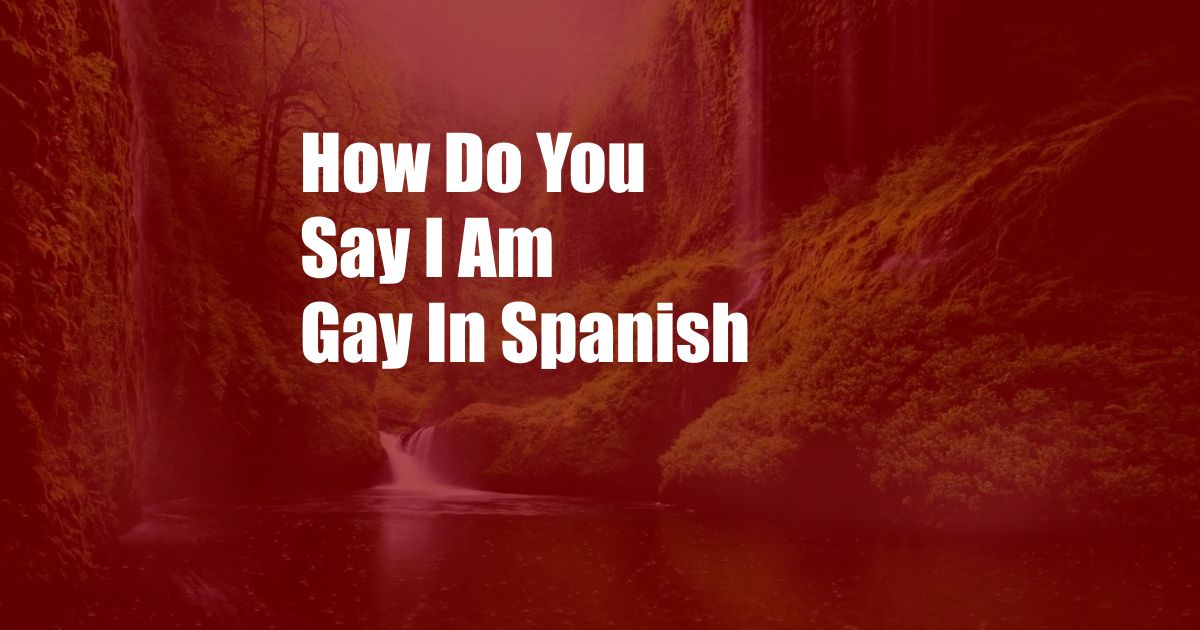
How to Say “I Am Gay” in Spanish
As a proud member of the LGBTQ+ community, I understand the significance of being able to express oneself authentically. When traveling or interacting with Spanish-speaking individuals, it’s essential to know the correct way to disclose your sexual orientation. In this article, we’ll delve into the nuances of saying “I am gay” in Spanish, exploring its cultural context and providing practical tips for effective communication.
Before we dive into the specifics, let’s briefly address the historical and cultural context of homosexuality in Spanish-speaking countries. While societal attitudes towards LGBTQ+ individuals have evolved in recent years, there’s still a lingering stigma and discrimination in some regions. Understanding this context is crucial for navigating conversations about sexual orientation sensitively.
Soy Gay: A Simple and Direct Approach
The most straightforward way to express “I am gay” in Spanish is “Soy gay.” This phrase is widely understood and used throughout the Spanish-speaking world. It’s a clear and unambiguous statement that leaves no room for misinterpretation.
When using “Soy gay,” it’s important to be confident and assertive in your delivery. This will convey a sense of pride and self-acceptance, which can help break down any potential barriers or awkwardness. Additionally, it’s always a good idea to be respectful of cultural differences and avoid using derogatory or offensive language.
Pronouncing “Soy Gay” Correctly
To ensure proper pronunciation, here’s a breakdown of the individual words:
- Soy: Pronounced as “soy,” with a diphthong sound.
- gay: Pronounced as “guy,” with a soft “g” sound.
Combining the two words, the correct pronunciation of “Soy gay” is “soy guy.” It’s important to pronounce the words clearly and distinctly, especially in formal or professional settings.
Alternative Phrases: Exploring Nuances
While “Soy gay” is the most common way to express your sexual orientation in Spanish, there are other phrases that can convey the same meaning with slightly different nuances:
- Soy homosexual: This phrase is more formal and clinical, often used in medical or scientific contexts.
- Soy de la comunidad LGBTQ+: This phrase is more inclusive, as it identifies you as a member of the broader LGBTQ+ community.
- Me gustan los hombres: This phrase is more casual and colloquial, directly stating that you are attracted to men.
The choice of phrase ultimately depends on the specific context and your personal preferences. It’s important to use language that feels comfortable and authentic to you.
Tips and Expert Advice for Effective Communication
When disclosing your sexual orientation in Spanish, here are some tips to enhance your communication:
- Be prepared: Anticipate questions or reactions and have answers ready.
- Choose the right setting: Pick a private or comfortable place for the conversation.
- Be respectful: Understand that not everyone shares your perspective and be willing to listen to their views.
- Stay safe: Be aware of your surroundings and ensure your safety in unfamiliar situations.
Following these tips can help minimize any potential discomfort or misunderstandings while communicating your sexual orientation in Spanish.
FAQ: Common Questions and Clear Answers
- How do I say “I am lesbian” in Spanish?
- Is it offensive to say “Soy maricón”?
- How can I find LGBTQ+ resources in Spanish?
- How do I handle negative reactions?
You can say “Soy lesbiana.”
Yes, “maricón” is a derogatory term that should be avoided.
There are numerous online forums, organizations, and social media groups dedicated to providing support and resources.
Stay calm, be respectful, and seek support from trusted friends or family members.
Conclusion
Knowing how to express “I am gay” in Spanish is an essential tool for effective communication. Whether you’re traveling, interacting with Spanish-speaking friends, or simply navigating social situations, being able to articulate your sexual orientation confidently can foster inclusivity and understanding.
Remember, language is a powerful tool for expressing identity and building connections. By embracing the nuances of Spanish and understanding the cultural context, you can engage in meaningful conversations that celebrate diversity and promote acceptance.